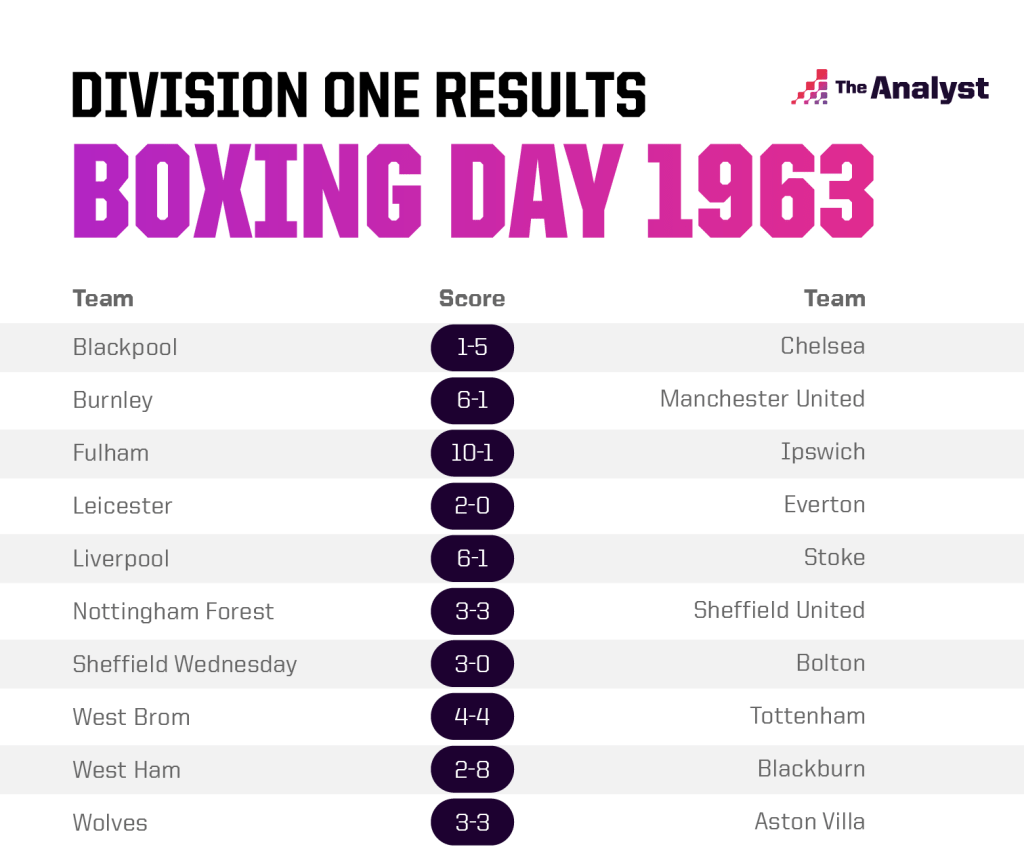For a decade now, not a single Christmas in England has taken place without multiple sightings of the scores in the Division One games on Boxing Day 1963, when there were 66 goals across 10 games. As far as anyone can recall, no one in the 1980s, 1990s or 2000s felt the need to reference an admittedly stellar (if you like goals) day in the English footballing calendar.
That changed, though, at Christmas 2011 when a newspaper – understandably looking to pre-fill pages at a busy and understaffed time of year – printed the now all too familiar set of 10 games, which were soon picked up by other publications and broadcasters across the globe, all of them entranced by this bizarre day of plenty in the planet’s favourite low-scoring sport.

Let’s not try and pretend such a day isn’t interesting in and of itself. The standout games were Fulham’s 10-1 win against Ipswich, which remains the most recent time an English top-flight side has hit double figures in a game. Fulham even managed to spread the goals perfectly, with five in the first half and five in the second. Meanwhile, winger Graham Leggat scored four times, with the first three coming in the 18th, 19th and 21st minutes, like some sort of Krays-era Sadio Mané. Fulham had scored 25 goals in 23 games going into this match, by the way, so this was a definite improvement in form.
Elsewhere there was another delightfully symmetrical game between West Ham and Blackburn, which ended 4-1 to Rovers in each half. Terry Venables scored for Chelsea away at Blackpool, Jimmy Greaves scored twice for Tottenham in their 4-4 draw at West Brom, the Baggies’ fourth goal bagged by the festive-themed Micky Fudge.
And unlike the vast majority of 1963-truthers, let’s not forget about the lower leagues, with Manchester City enjoying an 8-1 win against Scunthorpe with two players grabbing hat-tricks. Meanwhile, the only game in the four divisions to end goalless on Boxing Day 1963 was Crewe against Peterborough in the third tier. Still, more than 6,000 people turned up to watch it, because… well, why not?
Nobody would sensibly try and decry the antics of December 26 1963, it was clearly a fun old day, but in the 10 years since the results were resurfaced for a modern audience, the day has almost come to symbolise a lost age of carefree football, a sport weighed down with none of the problematic elements of modern football. Images of the scorelines from Boxing Day 1963 can be found being wielded on social media as a type of proof that old football was just better, things will never be as good as that again and we have somehow lost our way.
This ignores the fact that it happened less than three years after footballers had forced the abolition of the maximum wage, an overdue development bitterly fought by most club chairmen. Ask those brooding pipe-smoking administrators in 1961 whether they were against modern football and the answer would have been a resounding yes. At least they would have gleaned some enjoyment from seeing Johnny Haynes, the first £100 a week footballer, fail to get on the scoresheet in Fulham’s 10-1 win against Ipswich. What was his xG that day? We simply don’t know.
1961, the first Boxing Day post-abolition of the maximum wage, by the way, saw an incredibly average goals per game rate of 2.82. The media will never put those scores on a screen. They simply aren’t allowed to.
It’s also worth noting just what an outlier that 66-goal day is historically. Outside of the world wars, top-flight English football has been played on Boxing Day in virtually every year, other than those when December 26 fell on a Sunday. The average number of goals per Boxing Day across that entire period is 26.9. Only one year other than 1963 – 1893 – has seen more than five goals per game, with 1888 and 1955 seeing exactly 5.00 per game. The lowest figure is 1.33 in 1919, the first season back after the First World War. A third of the 12 goals that day were scored by West Brom, with four 1-0s and two 0-0s among the other eight games. Again, you’ll never see that set of scorelines shared enthusiastically online.
What stands out from the graph above is the vast majority of years where the Boxing Day goals per game is somewhere between 2.0 and 3.5 goals per game. That’s the industry standard for football, for nearly every era. Five years ago there were 3.63 goals per game on Boxing Day, the biggest bonanza since 1963 (excluding the four goals in one game oddity that was 1982), but the odds on 2017 being hailed as a heroic time in 50 years seems unlikely, not unless future generations religiously worship injury-time Jesse Lingard equalisers against Burnley.
Between 1983 and 1990, very much a venerated period of the game currently, the Boxing Day goals per game never climbed over three goals per game, although agricultural box-mouth scrambles apparently reached a new high. Many would counter by saying that you can’t judge an era’s significance just by the number of goals scored on a single day during the Christmas period. I agree, and so I never want to see the results from Boxing Day 1963 again. It’s time to move on.
Enjoy this? Subscribe to our mailing list to receive exclusive weekly content.
